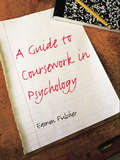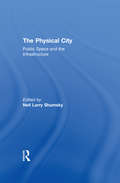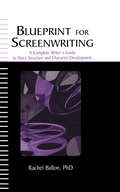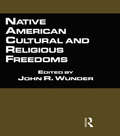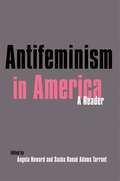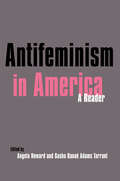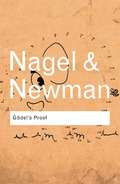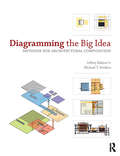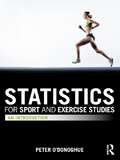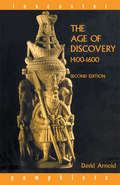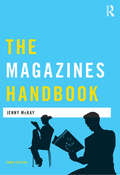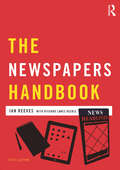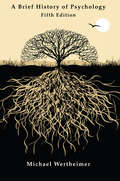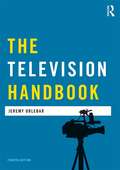- Table View
- List View
A Guide to Coursework in Psychology
by Eamon FulcherEver had difficulty choosing a research project? Ever wondered how your work will be marked? This book will help students to understand the coursework specifications and marking criteria for a number of key exam boards, including; AQA (specification A and B), OCR, EDEXCEL and SQA. It provides specific and highly relevant advice on how to maximise achievement in coursework. Guidance is offered on how best to choose a research project, through to practical advice on how to carry out research and write up reports. Topics to be avoided are also considered and advice on how to navigate the difficulties and avoid common pitfalls provided. Key issues covered include: * An overview of the main methods of investigation in psychology * Data analysis, including how to present data in Word and Excel and how best to comment on it * How to draw conclusions from data and create inferential statistics. Incorporating a series of examples, including an investigation from start to finish, and a laboratory experiment, this book provides clear, hands-on advice. It will be an invaluable tool for GCSE, AS and A2 students, helping them to maintain their motivation through coursework assignments and to achieve their potential.
The Physical City: Public Space and the Infrastructure
by Neil L. ShumskyFirst Published in 1996. Routledge is an imprint of Taylor & Francis, an informa company.
The Physical City: Public Space and the Infrastructure
by Neil L. ShumskyFirst Published in 1996. Routledge is an imprint of Taylor & Francis, an informa company.
Blueprint for Screenwriting: A Complete Writer's Guide to Story Structure and Character Development
by Rachel BallonBlueprint for Screenwriting demystifies the writing process by developing a "blueprint" for writers to follow for each new screenplay--from original concept to completed script. Author and international script consultant Dr. Rachel Ballon explores the writing craft and emphasizes creativity in the writing process. She blends her expertise in script analysis and writing coaching with her personal experience as a screenwriter to help writers construct their stories and characters.Starting with the story's framework, Dr. Ballon helps readers to understand the key "building blocks" of story structure and character development, including characters' emotional and psychological states, story conflicts, and scene and act structure. She also covers the essential components in the script writing process, such as outlines, script treatments, synopses, and formats. Dr. Ballon devotes a chapter to overcoming writer's block--the writer's greatest obstacle--and offers guidance for taking the next steps once a script is completed.A practical tool for any writer, this distinctive resource:*offers a blueprint for writers to follow, breaking the writing process down into specific, easy-to-follow steps;*stresses the psychology of the characters as well as that of the writer; and*offers first-hand knowledge of the screenwriting process and gives practical advice for completing and marketing scripts.With its unique and insightful approach to the writing process, this book will be indispensable for scriptwriters, fiction writers, and professional writers, and it will serve as a useful text in screenwriting courses.
Blueprint for Screenwriting: A Complete Writer's Guide to Story Structure and Character Development
by Rachel BallonBlueprint for Screenwriting demystifies the writing process by developing a "blueprint" for writers to follow for each new screenplay--from original concept to completed script. Author and international script consultant Dr. Rachel Ballon explores the writing craft and emphasizes creativity in the writing process. She blends her expertise in script analysis and writing coaching with her personal experience as a screenwriter to help writers construct their stories and characters.Starting with the story's framework, Dr. Ballon helps readers to understand the key "building blocks" of story structure and character development, including characters' emotional and psychological states, story conflicts, and scene and act structure. She also covers the essential components in the script writing process, such as outlines, script treatments, synopses, and formats. Dr. Ballon devotes a chapter to overcoming writer's block--the writer's greatest obstacle--and offers guidance for taking the next steps once a script is completed.A practical tool for any writer, this distinctive resource:*offers a blueprint for writers to follow, breaking the writing process down into specific, easy-to-follow steps;*stresses the psychology of the characters as well as that of the writer; and*offers first-hand knowledge of the screenwriting process and gives practical advice for completing and marketing scripts.With its unique and insightful approach to the writing process, this book will be indispensable for scriptwriters, fiction writers, and professional writers, and it will serve as a useful text in screenwriting courses.
Native American Cultural and Religious Freedoms
by John R. WunderFirst Published in 2000. Routledge is an imprint of Taylor & Francis, an informa company.
Antifeminism in America: A Historical Reader
by Gillian SwansonThe documents in this paperback inform the reader's understanding and appreciation of the social and political context of opposition in which the advocates of women's rights labored from 1848 to 1996. Arranged in six parts by historical periods, these original articles from mainstream magazines, specialized and academic journals, and books display the tone and substance of opposition to women's rights as it appeared in popular literature. The selections reflect the public campaign, fought in the popular press, of opponents to the fundamental goal of all aspects of movement for women's rights, to challenge the gender system by advocating equality for women.
Antifeminism in America: A Historical Reader
by Gillian SwansonThe documents in this paperback inform the reader's understanding and appreciation of the social and political context of opposition in which the advocates of women's rights labored from 1848 to 1996. Arranged in six parts by historical periods, these original articles from mainstream magazines, specialized and academic journals, and books display the tone and substance of opposition to women's rights as it appeared in popular literature. The selections reflect the public campaign, fought in the popular press, of opponents to the fundamental goal of all aspects of movement for women's rights, to challenge the gender system by advocating equality for women.
Godel's Proof
by Ernest Nagel James R. Newman'Nagel and Newman accomplish the wondrous task of clarifying the argumentative outline of Kurt Godel's celebrated logic bomb.' – The Guardian In 1931 the mathematical logician Kurt Godel published a revolutionary paper that challenged certain basic assumptions underpinning mathematics and logic. A colleague of physicist Albert Einstein, his theorem proved that mathematics was partly based on propositions not provable within the mathematical system. The importance of Godel's Proof rests upon its radical implications and has echoed throughout many fields, from maths to science to philosophy, computer design, artificial intelligence, even religion and psychology. While others such as Douglas Hofstadter and Roger Penrose have published bestsellers based on Godel’s theorem, this is the first book to present a readable explanation to both scholars and non-specialists alike. A gripping combination of science and accessibility, Godel’s Proof by Nagel and Newman is for both mathematicians and the idly curious, offering those with a taste for logic and philosophy the chance to satisfy their intellectual curiosity. Kurt Godel (1906 – 1978) Born in Brunn, he was a colleague of physicist Albert Einstein and professor at the Institute for Advanced Study in Princeton, N.J.
Godel's Proof
by Ernest Nagel James R. Newman'Nagel and Newman accomplish the wondrous task of clarifying the argumentative outline of Kurt Godel's celebrated logic bomb.' – The Guardian In 1931 the mathematical logician Kurt Godel published a revolutionary paper that challenged certain basic assumptions underpinning mathematics and logic. A colleague of physicist Albert Einstein, his theorem proved that mathematics was partly based on propositions not provable within the mathematical system. The importance of Godel's Proof rests upon its radical implications and has echoed throughout many fields, from maths to science to philosophy, computer design, artificial intelligence, even religion and psychology. While others such as Douglas Hofstadter and Roger Penrose have published bestsellers based on Godel’s theorem, this is the first book to present a readable explanation to both scholars and non-specialists alike. A gripping combination of science and accessibility, Godel’s Proof by Nagel and Newman is for both mathematicians and the idly curious, offering those with a taste for logic and philosophy the chance to satisfy their intellectual curiosity. Kurt Godel (1906 – 1978) Born in Brunn, he was a colleague of physicist Albert Einstein and professor at the Institute for Advanced Study in Princeton, N.J.
Diagramming the Big Idea: Methods for Architectural Composition
by Jeffrey Balmer Michael T. SwisherAs a beginning design student, you need to learn to think like a designer, to visualize ideas and concepts, as well as objects. In Diagramming the Big Idea, Jeffrey Balmer and Michael T. Swisher illustrate how you can create and use diagrams to clarify your understanding of both particular projects and organizing principles and ideas. With accessible, step-by-step exercises that interweave diagrams, drawings and virtual models, the authors clearly show you how to compose meaningful and useful diagrams. As you follow the development of the four project groups drawn from the authors’ teaching, you will become familiar with architectural composition concepts such as proportion, site, form, hierarchy and spatial construction. In addition, description and demonstration essays extend concepts to show you more examples of the methods used in the projects. Whether preparing for a desk critique, or any time when a fundamental insight can help to resolve a design problem, this book is your essential studio resource.
Diagramming the Big Idea: Methods for Architectural Composition
by Jeffrey Balmer Michael T. SwisherAs a beginning design student, you need to learn to think like a designer, to visualize ideas and concepts, as well as objects. In Diagramming the Big Idea, Jeffrey Balmer and Michael T. Swisher illustrate how you can create and use diagrams to clarify your understanding of both particular projects and organizing principles and ideas. With accessible, step-by-step exercises that interweave diagrams, drawings and virtual models, the authors clearly show you how to compose meaningful and useful diagrams. As you follow the development of the four project groups drawn from the authors’ teaching, you will become familiar with architectural composition concepts such as proportion, site, form, hierarchy and spatial construction. In addition, description and demonstration essays extend concepts to show you more examples of the methods used in the projects. Whether preparing for a desk critique, or any time when a fundamental insight can help to resolve a design problem, this book is your essential studio resource.
Action Research: Principles and practice
by Jean McNiffSince its first publication, Action Research: Principles and Practice has become a key text in its field. This new updated edition clearly describes and explains the practices of action research and its underlying values, and introduces important new ideas, including: all professionals should be reflective practitioners; they should produce their personal theories of practice to show how they are holding themselves accountable for their educational influences in learning; the stories they produce become a new people’s history of action research, with potential for influencing new futures. This new edition has expanded in scope, to contribute to diverse fields including professional development across the sectors and the disciplines. It considers the current field, including its problems as well as its considerable hopes and prospects for new thinking and practices. Now fully updated, this book contains: A wealth of case-study material New chapters on the educational significance of action research An overview of methodological and ethical discussion The book is a valuable addition to the literature on research methods in education and nursing and healthcare, and professional education, and contributes to contemporary debates about the generation and dissemination of knowledge and its potential influence for wider social and environmental contexts. Practitioners across the professions who are planning action research in their own work settings will find this book a helpful introduction to the subject while those studying on higher degree courses will find it an indispensable resource.
Action Research: Principles and practice
by Jean McNiffSince its first publication, Action Research: Principles and Practice has become a key text in its field. This new updated edition clearly describes and explains the practices of action research and its underlying values, and introduces important new ideas, including: all professionals should be reflective practitioners; they should produce their personal theories of practice to show how they are holding themselves accountable for their educational influences in learning; the stories they produce become a new people’s history of action research, with potential for influencing new futures. This new edition has expanded in scope, to contribute to diverse fields including professional development across the sectors and the disciplines. It considers the current field, including its problems as well as its considerable hopes and prospects for new thinking and practices. Now fully updated, this book contains: A wealth of case-study material New chapters on the educational significance of action research An overview of methodological and ethical discussion The book is a valuable addition to the literature on research methods in education and nursing and healthcare, and professional education, and contributes to contemporary debates about the generation and dissemination of knowledge and its potential influence for wider social and environmental contexts. Practitioners across the professions who are planning action research in their own work settings will find this book a helpful introduction to the subject while those studying on higher degree courses will find it an indispensable resource.
Statistics for Sport and Exercise Studies: An Introduction
by Peter O'DonoghueStatistics for Sport and Exercise Studies guides the student through the full research process, from selecting the most appropriate statistical procedure, to analysing data, to the presentation of results, illustrating every key step in the process with clear examples, case-studies and data taken from real sport and exercise settings. Every chapter includes a range of features designed to help the student grasp the underlying concepts and relate each statistical procedure to their own research project, including definitions of key terms, practical exercises, worked examples and clear summaries. The book also offers an in-depth and practical guide to using SPSS in sport and exercise research, the most commonly used data analysis software in sport and exercise departments. In addition, a companion website includes more than 100 downloadable data sets and work sheets for use in or out of the classroom, full solutions to exercises contained in the book, plus over 1,300 PowerPoint slides for use by tutors and lecturers. Statistics for Sport and Exercise Studies is a complete, user-friendly introduction to the use of statistical tests, techniques and procedures in sport, exercise and related subjects. Visit the companion website at: www.routledge.com/cw/odonoghue
Statistics for Sport and Exercise Studies: An Introduction
by Peter O'DonoghueStatistics for Sport and Exercise Studies guides the student through the full research process, from selecting the most appropriate statistical procedure, to analysing data, to the presentation of results, illustrating every key step in the process with clear examples, case-studies and data taken from real sport and exercise settings. Every chapter includes a range of features designed to help the student grasp the underlying concepts and relate each statistical procedure to their own research project, including definitions of key terms, practical exercises, worked examples and clear summaries. The book also offers an in-depth and practical guide to using SPSS in sport and exercise research, the most commonly used data analysis software in sport and exercise departments. In addition, a companion website includes more than 100 downloadable data sets and work sheets for use in or out of the classroom, full solutions to exercises contained in the book, plus over 1,300 PowerPoint slides for use by tutors and lecturers. Statistics for Sport and Exercise Studies is a complete, user-friendly introduction to the use of statistical tests, techniques and procedures in sport, exercise and related subjects. Visit the companion website at: www.routledge.com/cw/odonoghue
The Age of Discovery, 1400-1600
by David ArnoldThe Age of Discovery explores one of the most dramatic features of the late medieval and early modern period: when voyagers from Western Europe led by Spain and Portugal set out across the world and established links with Africa, Asia and the Americas. This book examines the main motivations behind the voyages and discusses the developments in navigation expertise and technology that made them possible.This second edition brings the scholarship up to date and includes two new chapters on the important topics of the idea of "discovery" and on biological and environmental factors which favoured or limited European expansion.
The Age of Discovery, 1400-1600
by David ArnoldThe Age of Discovery explores one of the most dramatic features of the late medieval and early modern period: when voyagers from Western Europe led by Spain and Portugal set out across the world and established links with Africa, Asia and the Americas. This book examines the main motivations behind the voyages and discusses the developments in navigation expertise and technology that made them possible.This second edition brings the scholarship up to date and includes two new chapters on the important topics of the idea of "discovery" and on biological and environmental factors which favoured or limited European expansion.
The Magazines Handbook
by Jenny McKayThe Magazines Handbook has firmly established itself as the essential introduction to the theories and practices of the modern magazine industry. This fully updated third edition comprehensively examines the business of publishing magazines today and the work of the contemporary magazine journalist. Jenny McKay draws examples from a broad range of publications to explore key jobs in the industry, covering everyone from the sub editor to the fashion assistant, as well as analysing the many skills involved in magazine journalism, including commissioning, researching, interviewing, and production. Updated specialist chapters discuss the growth and development of electronic publishing and online journalism, new directions in magazine design, photography and picture editing, and the most up to date legal frameworks in which magazine journalists must operate. The Magazines Handbook includes: • Interviews with magazine journalists, editors, and publishers • Advice on starting out and freelancing in the magazine industry • An analysis of ‘new journalism’ and reportage • A glossary of key terms and specialist concepts • Information on contacts, courses and professional training.
The Magazines Handbook
by Jenny McKayThe Magazines Handbook has firmly established itself as the essential introduction to the theories and practices of the modern magazine industry. This fully updated third edition comprehensively examines the business of publishing magazines today and the work of the contemporary magazine journalist. Jenny McKay draws examples from a broad range of publications to explore key jobs in the industry, covering everyone from the sub editor to the fashion assistant, as well as analysing the many skills involved in magazine journalism, including commissioning, researching, interviewing, and production. Updated specialist chapters discuss the growth and development of electronic publishing and online journalism, new directions in magazine design, photography and picture editing, and the most up to date legal frameworks in which magazine journalists must operate. The Magazines Handbook includes: • Interviews with magazine journalists, editors, and publishers • Advice on starting out and freelancing in the magazine industry • An analysis of ‘new journalism’ and reportage • A glossary of key terms and specialist concepts • Information on contacts, courses and professional training.
The Newspapers Handbook
by Richard Keeble Ian ReevesThis new edition of The Newspapers Handbook presents an enlightening examination of an ever-evolving industry, engaging with key contemporary issues, including reporting in the digital age and ethical and legislative issues following the hacking scandal to display a comprehensive anatomy of the modern newsroom. Richard Lance Keeble and Ian Reeves offer readers expert practical advice, drawing on a wide range of examples from print and digital news sources to illustrate best practice and the political, technological and financial realities of newspaper journalism today. Other key areas explored include: the language of news basic reporting the art of interviewing feature writing the role of social media in reporting investigative reporting court reporting reporting on national and local government guidance on training and careers for those entering the industry.
The Newspapers Handbook
by Richard Keeble Ian ReevesThis new edition of The Newspapers Handbook presents an enlightening examination of an ever-evolving industry, engaging with key contemporary issues, including reporting in the digital age and ethical and legislative issues following the hacking scandal to display a comprehensive anatomy of the modern newsroom. Richard Lance Keeble and Ian Reeves offer readers expert practical advice, drawing on a wide range of examples from print and digital news sources to illustrate best practice and the political, technological and financial realities of newspaper journalism today. Other key areas explored include: the language of news basic reporting the art of interviewing feature writing the role of social media in reporting investigative reporting court reporting reporting on national and local government guidance on training and careers for those entering the industry.
A Brief History of Psychology
by Michael WertheimerThis brief, inexpensive text offers the utmost in flexibility in teaching the history of psychology. Used as a stand-alone text or with readers, this engaging book is noted for its analysis of the scientific and philosophical emergence of the field. Readers appreciate the book’s balanced coverage of experimental, applied, and clinical psychology, as well as the clear and succinct presentation of the field’s major events and schools of thought. This edition features an expanded pedagogical program with bolded terms, a complete glossary, more illustrations, and web-based instructional materials including Power Points, a test bank, discussion questions, and more. Extensively updated throughout, this edition features: A new final chapter with a current analysis of the state of the field including the growth of specialized organizations that promote the science of psychology and the push to influence policies that address global challenges such as environmental sustainability, intergroup conflict, health disparities, and the population explosion. A discussion of the growth in the number and role of women in psychology and the promotion of diversity initiatives related to ethnicity, gender, age, and sexual orientation. Recent developments in the growth of neuroscience, cognitive science, and the diversification of psychology. Portraits of some major figures in the history of psychology. Recent changes in the practice of psychology including more emphasis on "evidence-based practice," prescription privileges, and the application of psychological principles to industrial and engineering psychology. Recent changes in the APA including new divisions and new elected officials. Used independently or as a supplement with readers, this brief text is intended for undergraduate and graduate courses on the history of psychology. Due to its brevity and engaging style, the book is often used in introductory courses to introduce students to the field. The enormous index and substantial glossary make this volume a useful desk reference for the entire field.
A Brief History of Psychology
by Michael WertheimerThis brief, inexpensive text offers the utmost in flexibility in teaching the history of psychology. Used as a stand-alone text or with readers, this engaging book is noted for its analysis of the scientific and philosophical emergence of the field. Readers appreciate the book’s balanced coverage of experimental, applied, and clinical psychology, as well as the clear and succinct presentation of the field’s major events and schools of thought. This edition features an expanded pedagogical program with bolded terms, a complete glossary, more illustrations, and web-based instructional materials including Power Points, a test bank, discussion questions, and more. Extensively updated throughout, this edition features: A new final chapter with a current analysis of the state of the field including the growth of specialized organizations that promote the science of psychology and the push to influence policies that address global challenges such as environmental sustainability, intergroup conflict, health disparities, and the population explosion. A discussion of the growth in the number and role of women in psychology and the promotion of diversity initiatives related to ethnicity, gender, age, and sexual orientation. Recent developments in the growth of neuroscience, cognitive science, and the diversification of psychology. Portraits of some major figures in the history of psychology. Recent changes in the practice of psychology including more emphasis on "evidence-based practice," prescription privileges, and the application of psychological principles to industrial and engineering psychology. Recent changes in the APA including new divisions and new elected officials. Used independently or as a supplement with readers, this brief text is intended for undergraduate and graduate courses on the history of psychology. Due to its brevity and engaging style, the book is often used in introductory courses to introduce students to the field. The enormous index and substantial glossary make this volume a useful desk reference for the entire field.
The Television Handbook
by Jeremy OrlebarThe Television Handbook is a critical introduction to the practice and theory of television. The book examines the state of television today, explains how television is made and how production is organised, and discusses how critical thinking about programmes and genres can illuminate their meanings. This book also explores how developments in technology and the changing structure of the television industry will lead the medium in new directions. The Television Handbook gives practical advice on many aspects of programme making, from an initial programme idea through to shooting and the post-production process. The book includes profiles giving insight into how personnel in the television industry - from recent graduates to television executives - think about their work. The Television Handbook offers chapters on the vigorous debates about what is meant by quality television, how news and factual programmes are responding to interactive technologies, and how formats such as Reality/Talent TV have risen in prominence. It also considers how drama, sport and music television can be discussed and interpreted. The Television Handbook includes: Profiles of TV news and drama producers, editors and TV studio personnel Case histories of important TV genres and series Practical programme making advice Explanations of key theoretical perspectives in television studies
